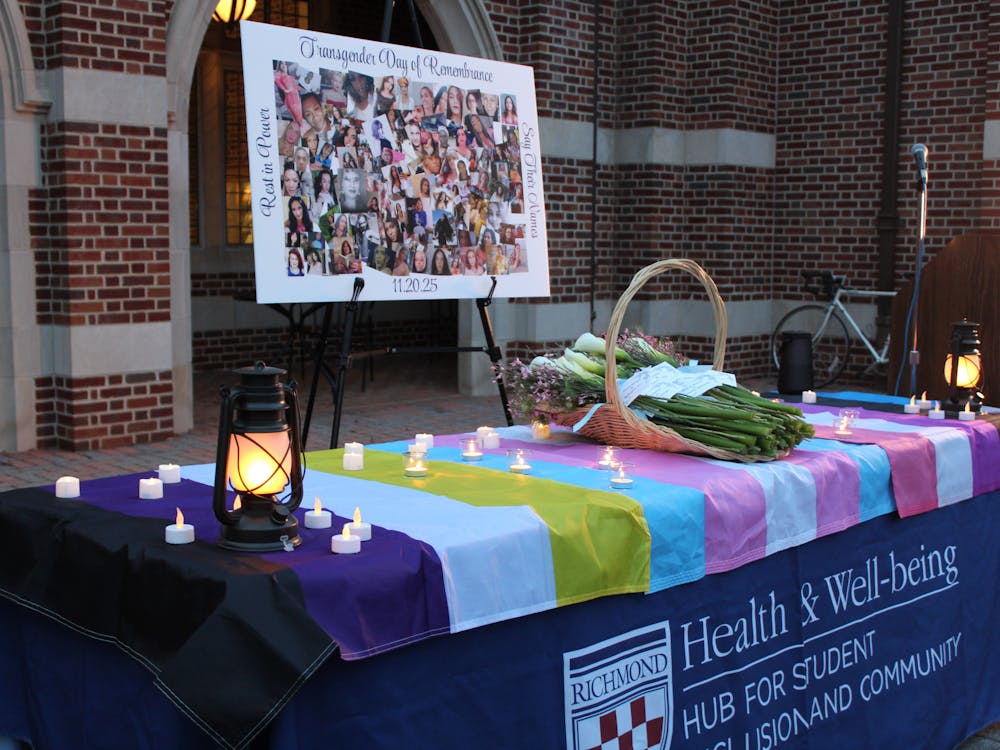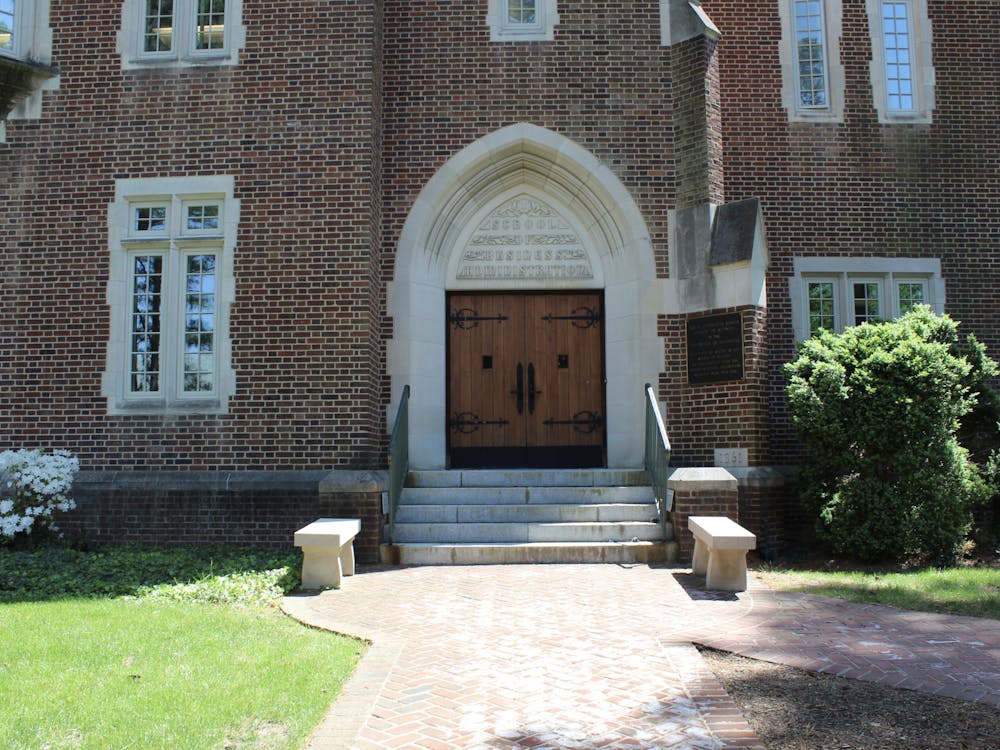The Bias Response Team has received attention around campus since October when it responded to both an explicit fraternity e-mail sent campus-wide and a swastika that was carved into a table outside the T.C. Williams School of Law.
The BRT is a new initiative at Richmond created to respond to incidents that undermine the safe learning environment at Richmond, according to the Common Ground Web site detailing the BRT.
The site defines bias incidents as acts that mock, degrade, threaten or assault others, and the motivation for the act is based on social differences such as race, ethnicity, gender, sexuality, ability status, nationality or religion.
Although the BRT was created to respond to these incidents, it does not replace anything that already exists -- student and staff policies, police investigations, judicial hearings, etc., said Glyn Hughes, chairman of the BRT and director of Common Ground.
"The BRT gets campus leaders together when an incident looks like it is going to be, or already is, a community event," he said.
The level of response is handled on a case-by-case basis, Hughes said. It depends on whether it is deemed the community needs to hear information about a specific event because people have expressed deep concern, feel vulnerable or need information about the resources available for support.
Hughes said the spirit of the BRT was not about policing, stifling free speech or academic freedom, and that it was in place to make sure that the university had a mechanism to deal with bias incidents on an institutional level.
"It is not about pursuing the issue, it's about helping the community," he said.
The fraternity e-mail and swastika incidences were the first the BRT responded to as a group. Although these cases may have been the first time some students, faculty and staff had heard of the response team, the BRT started developing last spring in response to other incidents, Hughes said.
The administration realized it needed to find a way to address these issues and President Edward Ayers approached some people to create a response team, Richmond College Dean Joe Boehman said.
Hughes said he had looked at institutions with similar response teams, and Richmond's team incorporated ideas from various protocols. Some of the other colleges and universities he looked at were the University of Virginia, The College of William and Mary, University of Chicago, University of Vermont and the University of Oregon.
"I think a lot of people thought it was formed after the e-mail had been sent and that was not the case," said Matt Whittaker, Richmond College Student Government Association president.
Enjoy what you're reading?
Signup for our newsletter
The BRT was set to have its first formal team meeting the Friday the fraternity e-mail leaked. Instead, the team met to respond and Hughes said the response ran pretty smoothly because the team's protocol was already in place.
It was unfortunate timing because the BRT members were supposed to meet and detail the role the group was going to take on campus, Boehman said, but then the team had to get together and initiate right away.
Looking back, there were some things that could have been done better, Whittaker said, but that is what the team has to deal with when it "tries by fire."
There are five steps, according to the BRT's Web site, in the team's protocol for dealing with bias-related incidents - ensure prompt, clear communication among relevant parties and the university community as a whole coordinate support by those affected by the incident; promote learning opportunities within the university community; recommend necessary policy changes; and ensure that investigations are thorough, transparent and, to the extent possible, that results are made public.
When the BRT meets, it works with a sheet that has sections for each of these five levels of response, which team members can fill in with notes and appropriate information from the case. This allows the team to figure out who knows what and whether or not everyone who should be talking to each other is actually communicating, Hughes said.
The team is composed of people on campus in various positions. Members, as listed on the Web site, include the provost, director of multicultural affairs, director of Common Ground, director of counseling and psychology, the interim university chaplain, associate vice president of human resources, university president's chief of staff, assistant vice president for communications, Richmond and Westhampton College deans, student government presidents, vice president for student development, chief of police and university general counsel.
It is valuable to have leaders of the university together regularly to talk about campus climate whether it is in response to a specific incident or not, Hughes said.
Boehman commented on an opinion article printed in The Collegian by Jarrett Dieterle, which made particular mention of the BRT.
The article described the response team as an "unnecessary institutional bureaucracy, which is charged with a mission, but given few tools to succeed."
Dieterle continued in the article to describe the BRT as "an attempt to make it appear as though the university was committed to taking action."
The BRT was not designed to be a team that actually has power, Boehman said.
Its role is to ensure that all areas of response have been addressed, the right amount of information has been released and that all parties involved feel at ease and safe, he said.
Boehman also addressed the concern expressed in the article about e-mails sent by the administration during the incident-response process.
"Our community needs one e-mail from our president himself that confronts what happened, lists the facts and describes what will be done in response," the article reads. "After the e-mail incident occurred, I distinctly remember shaking my head with every e-mail I received in my inbox from yet another school administrator. It was as though everyone wanted to get their two cents in on the situation."
"We are concerned that people are becoming desensitized to incidences where e-mails are sent," Boehman said.
One thing the BRT can work on is making sure that the appropriate people involved with a specific incident are the ones sending the e-mails to help ensure they do not lose impact and are not always coming from Ayers, he said.
Hughes said he had met with a number of faculty, staff and student groups on campus - student government presidents, resident assistants, Panhellenic and IFC representatives, faculty members, the athletics department - to let people know about the BRT initiative, explain its function and ease any questions or concerns people may have.
One question Hughes posed for those who did not appear to fully understand the BRT and may have thought it was responsible for handling policy decisions was, What has the BRT actually done?
His answer was that it has sent out two e-mails - one for the swastika and one for the fraternity e-mail - describing procedures being followed and alerting the community that the proper authorities had taken control.
"It's putting a structure in place and a set of procedures in place to have a timely response to incidents," Whittaker said. "I think students need to see it in action and appreciate it for what it is."
Students may not fully value the BRT, but those who are involved in these incidents first-hand will and it is important to respond to incidents like the e-mail this year and the black doll in a noose found last year, he said.
Faculty members also expressed concern.
"The faculty brought up a really good point," he said, "which is that the protocol, as written, suggests that for things that are very minor and borderline, it sounds like we are saying, 'call the police.'"
Because of these concerns, Hughes said the BRT was reevaluating how some of these situations were addressed. Faculty members were not able to be reached for comment on the BRT or the meeting.
"One phenomenon that happens is that once you devote an organization's resources to deal with a problem, you very often will hear about more incidences because you have made it clear that you want to hear," Hughes said.
The BRT plans to meet sometime this month to discuss what it had hoped to cover during its October meeting, he said. Hughes said team membes also planned to discuss how to respond to these incidents with people outside the school, such as news outlets, alumni, and trustees.
Contact staff writer Jessica Murray at jessica.murray@richmond.edu
Support independent student media
You can make a tax-deductible donation by clicking the button below, which takes you to our secure PayPal account. The page is set up to receive contributions in whatever amount you designate. We look forward to using the money we raise to further our mission of providing honest and accurate information to students, faculty, staff, alumni and others in the general public.
Donate Now


